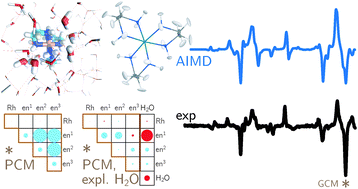-
Where does the Raman optical activity of [Rh(en)3]3+ come from? Insight from a combined experimental and theoretical approach
M. Humbert-Droz, P. Oulevey, L.M. Lawson Daku, S. Luber, H. Hagemann and T. Bürgi
Phys. Chem. Chem. Phys., 16 (42) (2014), p23260-23273


DOI:10.1039/C4CP02145B | unige:40863 | Abstract | Article HTML | Article PDF

Backscattered Raman optical activity (ROA) spectra are measured for Δ- and Λ-tris-(ethylenediamine)rhodium(III) chloride in aqueous solution. In addition, the spectra of the four possible conformers in the Λ configuration are investigated by ab initio calculations. The Λ(δδδ) conformer is in best agreement with experimental spectra and examined in more details. The two most stable conformers according to the calculations are not compatible with the experimental ROA spectrum. Insights into the origin of observed band intensities are obtained by means of group coupling matrices. The influence of the first solvation shell is explored via an ab initio molecular dynamics simulation. Taking explicit solvent molecules into account further improves the agreement between calculation and experiment. Analysis of selected normal modes using group coupling matrices shows that solvent molecules lead to normal mode rotation and thus contribute to the ROA intensity, whereas the contribution of the Rh can be neglected.